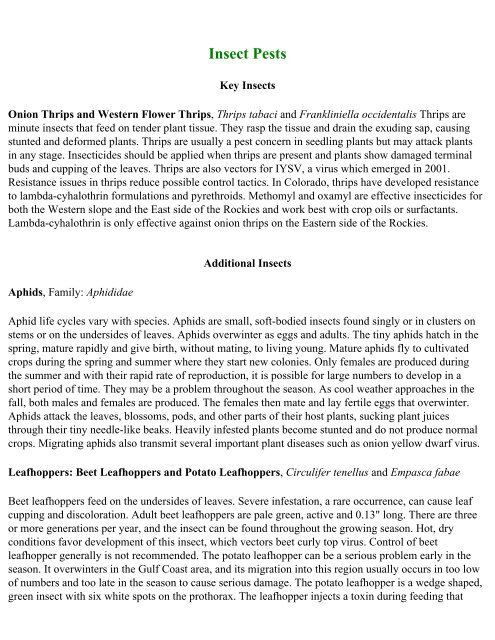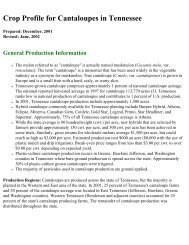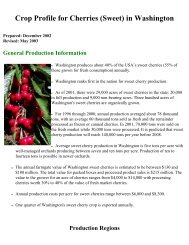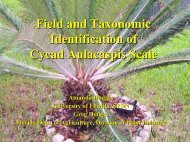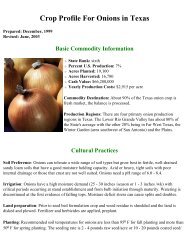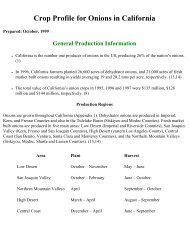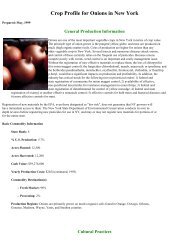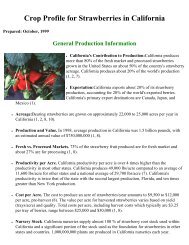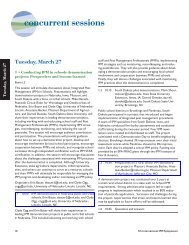Crop Profile for Onions in Colorado - Regional IPM Centers
Crop Profile for Onions in Colorado - Regional IPM Centers
Crop Profile for Onions in Colorado - Regional IPM Centers
Create successful ePaper yourself
Turn your PDF publications into a flip-book with our unique Google optimized e-Paper software.
Insect Pests<br />
Key Insects<br />
Onion Thrips and Western Flower Thrips, Thrips tabaci and Frankl<strong>in</strong>iella occidentalis Thrips are<br />
m<strong>in</strong>ute <strong>in</strong>sects that feed on tender plant tissue. They rasp the tissue and dra<strong>in</strong> the exud<strong>in</strong>g sap, caus<strong>in</strong>g<br />
stunted and de<strong>for</strong>med plants. Thrips are usually a pest concern <strong>in</strong> seedl<strong>in</strong>g plants but may attack plants<br />
<strong>in</strong> any stage. Insecticides should be applied when thrips are present and plants show damaged term<strong>in</strong>al<br />
buds and cupp<strong>in</strong>g of the leaves. Thrips are also vectors <strong>for</strong> IYSV, a virus which emerged <strong>in</strong> 2001.<br />
Resistance issues <strong>in</strong> thrips reduce possible control tactics. In <strong>Colorado</strong>, thrips have developed resistance<br />
to lambda-cyhalothr<strong>in</strong> <strong>for</strong>mulations and pyrethroids. Methomyl and oxamyl are effective <strong>in</strong>secticides <strong>for</strong><br />
both the Western slope and the East side of the Rockies and work best with crop oils or surfactants.<br />
Lambda-cyhalothr<strong>in</strong> is only effective aga<strong>in</strong>st onion thrips on the Eastern side of the Rockies.<br />
Aphids, Family: Aphididae<br />
Additional Insects<br />
Aphid life cycles vary with species. Aphids are small, soft-bodied <strong>in</strong>sects found s<strong>in</strong>gly or <strong>in</strong> clusters on<br />
stems or on the undersides of leaves. Aphids overw<strong>in</strong>ter as eggs and adults. The t<strong>in</strong>y aphids hatch <strong>in</strong> the<br />
spr<strong>in</strong>g, mature rapidly and give birth, without mat<strong>in</strong>g, to liv<strong>in</strong>g young. Mature aphids fly to cultivated<br />
crops dur<strong>in</strong>g the spr<strong>in</strong>g and summer where they start new colonies. Only females are produced dur<strong>in</strong>g<br />
the summer and with their rapid rate of reproduction, it is possible <strong>for</strong> large numbers to develop <strong>in</strong> a<br />
short period of time. They may be a problem throughout the season. As cool weather approaches <strong>in</strong> the<br />
fall, both males and females are produced. The females then mate and lay fertile eggs that overw<strong>in</strong>ter.<br />
Aphids attack the leaves, blossoms, pods, and other parts of their host plants, suck<strong>in</strong>g plant juices<br />
through their t<strong>in</strong>y needle-like beaks. Heavily <strong>in</strong>fested plants become stunted and do not produce normal<br />
crops. Migrat<strong>in</strong>g aphids also transmit several important plant diseases such as onion yellow dwarf virus.<br />
Leafhoppers: Beet Leafhoppers and Potato Leafhoppers, Circulifer tenellus and Empasca fabae<br />
Beet leafhoppers feed on the undersides of leaves. Severe <strong>in</strong>festation, a rare occurrence, can cause leaf<br />
cupp<strong>in</strong>g and discoloration. Adult beet leafhoppers are pale green, active and 0.13" long. There are three<br />
or more generations per year, and the <strong>in</strong>sect can be found throughout the grow<strong>in</strong>g season. Hot, dry<br />
conditions favor development of this <strong>in</strong>sect, which vectors beet curly top virus. Control of beet<br />
leafhopper generally is not recommended. The potato leafhopper can be a serious problem early <strong>in</strong> the<br />
season. It overw<strong>in</strong>ters <strong>in</strong> the Gulf Coast area, and its migration <strong>in</strong>to this region usually occurs <strong>in</strong> too low<br />
of numbers and too late <strong>in</strong> the season to cause serious damage. The potato leafhopper is a wedge shaped,<br />
green <strong>in</strong>sect with six white spots on the prothorax. The leafhopper <strong>in</strong>jects a tox<strong>in</strong> dur<strong>in</strong>g feed<strong>in</strong>g that


